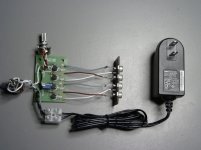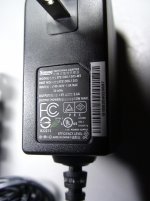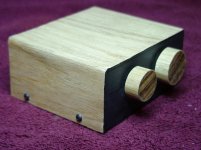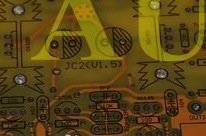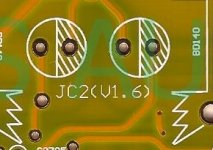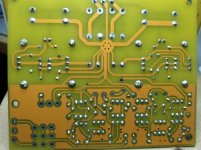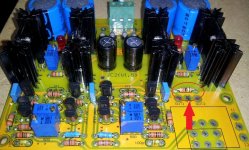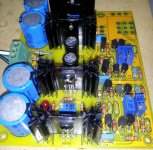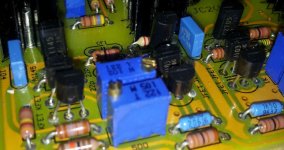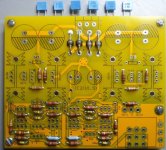Squalor, The 30VA 15+15 should be worth a try, but a message to stantontin@gmail.com will get you a direct answer.
I don't want to lead anyone astray by suggesting anything more than a bare pot is needed for excellent sound with the FEs. An active preamp and/or discrete passive attenuator is only intended to be an option for those with speaker or source difficulties/requirements. Remember, I went through the entire beta process with a bare pot.
If a separate unit is desired and cost is a factor, I highly recommend Uriah's Lightspeed or similar design. Its acoustic performance is very close to its big brother. In fact, when I suggested to Uriah that I wish he could design a Lightspeed with an on-board power supply - he laughed and said "that's what the Lighter Note is" 🙂 The advantage of the extra circuitry in the LN is the ability to more accurately dial in its operation to match any given system. That's a great feature but not a necessity.
For power I have always used a leftover 5V wall wart plucked from the pile. (I'm sure you have a collection too) SoIL4x4's suggestion for the regi-reg is something I might try in the future.
I don't want to lead anyone astray by suggesting anything more than a bare pot is needed for excellent sound with the FEs. An active preamp and/or discrete passive attenuator is only intended to be an option for those with speaker or source difficulties/requirements. Remember, I went through the entire beta process with a bare pot.
If a separate unit is desired and cost is a factor, I highly recommend Uriah's Lightspeed or similar design. Its acoustic performance is very close to its big brother. In fact, when I suggested to Uriah that I wish he could design a Lightspeed with an on-board power supply - he laughed and said "that's what the Lighter Note is" 🙂 The advantage of the extra circuitry in the LN is the ability to more accurately dial in its operation to match any given system. That's a great feature but not a necessity.
For power I have always used a leftover 5V wall wart plucked from the pile. (I'm sure you have a collection too) SoIL4x4's suggestion for the regi-reg is something I might try in the future.
Attachments
Last edited:
So on picture 2 of the 5 you just posted, that is Uriah's LDR correct ? That's what I have. Which pot is the volume ? Is the other pot the balance ? Is the balance (in this case, LDR) not for panning left to right but for tuning to find equal volume for both channels ?
I thought I read somewhere that a switching PSU like in a wal-wart is not as good. Also, I suppose we should only say Lightspeed when talking about the George Stanshef (sp ?) version ?
Back to the JC-2 (or should I call it the JA pre so as not to tick off Mr. Curl). Isn't it able to make more SPL than a B1 or a bare pot ?
You know by now that I'm kinda dense so please help me wrap my mind around this. A bare potentiometer adds a bit of it's own sound signature because of it's wiper material and construction. It's why some people seek out pots by Nobel or Alps. A stepped attenuator makes a cleaner signal because it used fixed resistors of decreasing values instead of a wiper. A LDR uses Silonex light resistors to control input signal, the pot is not in the signal chain so it is very clean. The LDR pot does not need a extention shaft, it can be mounted next to a transformer at the front of the chassis. Only leads from the LDR module to the amp and input RCA's need to be short and high quality. The Silonex light resistors must remain cool during assembly and use. A person could use a LDR module in place of a Alps 27 pot to control a JC-2. A JC-2 only controls volume if one adds a volume pot, attenuator or LDR at the front end of it. Otherwise, it's just a input signal booster. A Pass B1 (or Salas DCB1) in basic form does not control volume and has (no gain) unity gain. Are any of these statements over-simplified ?
Why do you think so many people are on the DCB1 band wagon ? What does it do ?
I thought I read somewhere that a switching PSU like in a wal-wart is not as good. Also, I suppose we should only say Lightspeed when talking about the George Stanshef (sp ?) version ?
Back to the JC-2 (or should I call it the JA pre so as not to tick off Mr. Curl). Isn't it able to make more SPL than a B1 or a bare pot ?
You know by now that I'm kinda dense so please help me wrap my mind around this. A bare potentiometer adds a bit of it's own sound signature because of it's wiper material and construction. It's why some people seek out pots by Nobel or Alps. A stepped attenuator makes a cleaner signal because it used fixed resistors of decreasing values instead of a wiper. A LDR uses Silonex light resistors to control input signal, the pot is not in the signal chain so it is very clean. The LDR pot does not need a extention shaft, it can be mounted next to a transformer at the front of the chassis. Only leads from the LDR module to the amp and input RCA's need to be short and high quality. The Silonex light resistors must remain cool during assembly and use. A person could use a LDR module in place of a Alps 27 pot to control a JC-2. A JC-2 only controls volume if one adds a volume pot, attenuator or LDR at the front end of it. Otherwise, it's just a input signal booster. A Pass B1 (or Salas DCB1) in basic form does not control volume and has (no gain) unity gain. Are any of these statements over-simplified ?
Why do you think so many people are on the DCB1 band wagon ? What does it do ?
The DCB1 and all other buffers, allows an inadequate Source to drive the interconnects feeding the Receiver.
inadequate Source like the headphone out of a smart phone with 6 meter RCA cord would present a weak signal to a amp ? Same headphone out to a DCB1 to the 16 meter interconnect sounds detailed and effortless ?
No gain but maybe a 4V line level signal ?
No gain but maybe a 4V line level signal ?
So on picture 2 of the 5 you just posted, that is Uriah's LDR correct ? That's what I have. Which pot is the volume ? Is the other pot the balance ?
Yes, that is the Lightspeed.The big pot is volume.The small one is balance but it only operates within a small range. It should probably be called a "centering" pot as it does not effect the volume overtly.
Is the balance (in this case, LDR) not for panning left to right but for tuning to find equal volume for both channels ?
I thought I read somewhere that a switching PSU like in a wal-wart is not as good. Also, I suppose we should only say Lightspeed when talking about the George Stanshef (sp ?) version ?
There are probably beter ways to power this, but what I have works for me. I got the Lighter Note before I had a chance to investigate.
Back to the JC-2 (or should I call it the JA pre so as not to tick off Mr. Curl). Isn't it able to make more SPL than a B1 or a bare pot ?
Yes, the only reason I bought the JC-2 was for the gain. I have low efficiency speakers. I like my Big Band music loud and screaming , thus the need for some gain
You know by now that I'm kinda dense so please help me wrap my mind around this. A bare potentiometer adds a bit of it's own sound signature because of it's wiper material and construction. It's why some people seek out pots by Nobel or Alps. A stepped attenuator makes a cleaner signal because it used fixed resistors of decreasing values instead of a wiper. A LDR uses Silonex light resistors to control input signal, the pot is not in the signal chain so it is very clean.
You are correct in all of that. It's also why I recommend that single pot (again Dario's discovery) in the picture. One quality pot is much cleaner and has fewer potential anomalies than any collection of resistor, caps, diodes, ICs and such IMO.
The LDR pot does not need a extention shaft, it can be mounted next to a transformer at the front of the chassis. Only leads from the LDR module to the amp and input RCA's need to be short and high quality. The Silonex light resistors must remain cool during assembly and use. A person could use a LDR module in place of a Alps 27 pot to control a JC-2. A JC-2 only controls volume if one adds a volume pot, attenuator or LDR at the front end of it. Otherwise, it's just a input signal booster.
Correct again. Take a look at the integrated thread to see that exact configuration. The LN is acting as the pot for the JC-2. Very good results but definately overkill.
A Pass B1 (or Salas DCB1) in basic form does not control volume and has (no gain) unity gain. Are any of these statements over-simplified ?
Why do you think so many people are on the DCB1 band wagon ? What does it do ?
You will have to address this last part to someone else - I have no experience with either.
Hope that helps.
- - - - - - - - - - - -
Man, is that not the ugliest post you've ever seen?😱 I dropped out of art class!
Last edited:
Nah, it was colorful.....and helpful. Andrew's was too. I'm going to put my DCB1 on the back burner. I may join you guys later in this thread but for now I will watch from the sidelines. My C-note just got spunt on new IC's for the FE. Along with that order I'm getting some Caddock goodness and even Susumu RG20 for my R12.Man, is that not the ugliest post you've ever seen
Since you've been so helpful and offered me your couch durring my WAF issues I'd like to do something for you. I've got something for you to try at C13. Russian 1uF K75-10 ! Shoot me a PM with a address and I'll drop them in the mail for you.
Headphones are a Receiver. They recieve a signal from an interconnect.inadequate Source like the headphone out of a smart phone with 6 meter RCA cord would present a weak signal to a amp ? Same headphone out to a DCB1 to the 16 meter interconnect sounds detailed and effortless ?
The Smartphone is, if I understand correctly, a Source component. It sends a signal to an interconnect.
4Vac from an active buffer fed with +-10Vdc is asking quite a lot. You are going to be in quite a high proportion (about 50%, or -6dB) of the maximum capability of the buffer and that is normally a high distortion region of operation for a Single Ended ClassA amplifier without feedback.No gain but maybe a 4V line level signal ?
Last edited:
Why do you think so many people are on the DCB1 band wagon ? What does it do ?
With today sources a pre with gain is rarely needed.
That's why so much people use passive pres with success.
But the insertion of the pot in the connection between source and power amp affects impedance presented to the power amp possibly affecting frequency response and dynamic.
A buffer, like the DCB1, helps presenting a low impedance to the power amp and since it's unity gain is, hopefully, more linear than a pre with gain.
Here is a preliminary shot at some parts substitutions from Dario. A version based on hands-on experience will follow in a few weeks.
* * * * *
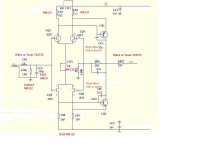
......but all that Caddock would cost a fortune, I would probably use them only for LR0 and, maybe, LR01.
LC0 should be also important and I would use a Amtrans AMCH or , at least, a Wima FKP2.
* * * * *
Looks like it will be another fun ride. All suggestions, theories and opinions (about the pre 😉 ) are welcomed. I'll do a cost estimate of this package and post it shortly.
* * * * *

......but all that Caddock would cost a fortune, I would probably use them only for LR0 and, maybe, LR01.
LC0 should be also important and I would use a Amtrans AMCH or , at least, a Wima FKP2.
* * * * *
Looks like it will be another fun ride. All suggestions, theories and opinions (about the pre 😉 ) are welcomed. I'll do a cost estimate of this package and post it shortly.
Just for the fun of it I also ordered one of this kits 😀
One thing I noticed; In the picture of the kit the PCB is printed V1.5 while on the board which he is selling separately it says V1.6
Regards
One thing I noticed; In the picture of the kit the PCB is printed V1.5 while on the board which he is selling separately it says V1.6
Regards
I just asked him the question via Ebay.
Maybe it's an old picture like you said. Just wait and see what he will answer.
Regards
Maybe it's an old picture like you said. Just wait and see what he will answer.
Regards
This is the reply I just received from Jim's Audio.
"The schematic is the same since v1.2. The changes are only some trace rerouting.
The current kit in stock is v1.6."
So, mystery solved. 🙂
Regards
"The schematic is the same since v1.2. The changes are only some trace rerouting.
The current kit in stock is v1.6."
So, mystery solved. 🙂
Regards
My kit arrived today. 🙂
Regards
Wow. That was quick. How does it look?
Great, It will be interesting to hear your impressions. Make sure you pay attention to all the transistor numbering/markings. I had to start over cause I didn't. Everything is pretty straight forward. Double check that there are no cold solder joints before powering up.
Good Luck.
Good Luck.
Last edited:
- Status
- Not open for further replies.
- Home
- Source & Line
- Analog Line Level
- JA Pre and MyRef - FE Integration

